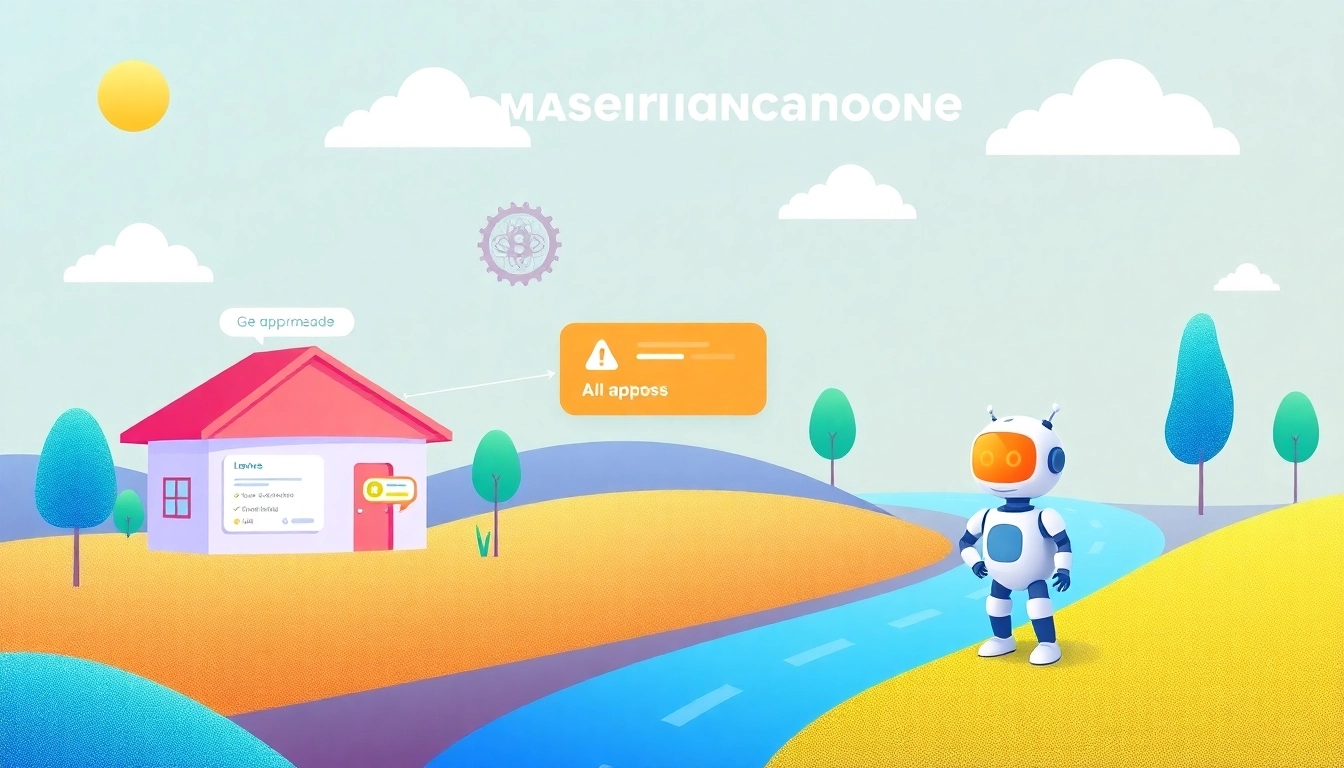Understanding the Mortgage Process with AI
The mortgage process can often be complex and daunting for prospective homeowners. However, the integration of artificial intelligence (AI) is revolutionizing this landscape, making the mortgage process with AI more efficient and user-friendly. This transformation is not just about speeding up operations; it’s about enhancing the overall borrower experience and ensuring compliance across the board.
What is the Mortgage Process?
The mortgage process involves several steps that a borrower goes through from applying for a loan to closing on a home. Traditionally, this process includes:
- Pre-qualification: This step involves assessing your finances to determine how much you can borrow.
- Loan Application: Filling out the mortgage application with both personal and financial information.
- Document Submission: Providing necessary documentation such as bank statements, tax returns, and pay stubs.
- Underwriting: The lender assesses your creditworthiness and the risks associated with granting you a loan.
- Loan Approval: If everything checks out, your loan is issued, and you’ll receive a formal approval.
- Closing: Final step where you sign all the documents, pay closing costs, and take possession of the property.
Each stage is crucial and can influence the speed and success of obtaining a mortgage. Integrating AI into this process streamlines various tasks, making it easier for borrowers and lenders alike.
How AI is Integrated into Mortgage Services
AI technologies are being embedded throughout different stages of the mortgage process. Key areas where AI is making significant inroads include:
- Application Processing: AI can automate the data entry process, reducing the need for manual input and expediting the application procedure.
- Document Verification: Utilizing Optical Character Recognition (OCR) technology, AI can swiftly scan and validate documents ensuring accuracy and speed.
- Risk Assessment: AI algorithms can analyze borrower data to assess risks more effectively than traditional methods.
- Customer Support: Chatbots and virtual assistants powered by AI provide immediate assistance to borrowers, guiding them through the process.
By implementing these technologies, lenders improve their operational efficiency and offer a smoother experience for borrowers.
Key Benefits of AI in Mortgage Processing
The incorporation of AI in the mortgage process yields several advantages:
- Speed: Automation reduces processing times, allowing loans to close faster than traditional methods.
- Accuracy: AI minimizes human errors, enhancing the reliability of data processing and decision-making.
- Cost Savings: Streamlined processes lead to decreased operational costs for lenders, which can translate to better rates for borrowers.
- Improved Compliance: AI systems can continuously monitor compliance with regulations, reducing the risks of violations.
These benefits are changing the mortgage landscape, allowing lenders to focus more on customer service and strategic growth.
Enhancing Efficiency in the Mortgage Process
AI Technologies Transforming Workflow
Various AI technologies combine to revolutionize the efficiency of workflows in mortgage processing. For instance:
- Machine Learning: AI systems can learn from vast amounts of mortgage data, enabling better predictions and faster approval times.
- Predictive Analytics: By analyzing past loan performance, lenders can predict future borrower behavior, influencing their lending strategies.
- Automation Tools: Robotic process automation (RPA) can handle repetitive tasks such as data entry and document management.
The utilization of such technologies significantly reduces turnaround times, providing a distinct advantage in a competitive market.
Case Studies of AI Implementation
Multiple companies have successfully integrated AI into their mortgage processes. For example:
- Rocket Mortgage: This company employs AI to streamline the loan application and closing processes. Their approach significantly reduces the time needed for approvals.
- Wells Fargo: By implementing AI-driven chatbots, they improved customer interactions, allowing clients to get immediate answers regarding their loans.
These case studies highlight how AI can lead to innovative practices that enhance borrower experience and operational efficiencies.
Common Challenges and Solutions
While the adoption of AI in mortgage processing offers tremendous benefits, it also comes with challenges:
- Data Privacy: Handling sensitive client information requires stringent compliance with regulations. Lenders must establish secure systems.
- Integration Issues: Implementing new AI systems can disrupt existing processes. Companies should phase in changes carefully.
- Training Staff: Employees may require training to work effectively with AI tools, thereby requiring time and resources.
By recognizing and addressing these challenges, companies can foster smoother transitions into AI-enhanced workflows.
Compliance and Risk Management with AI
How AI Assists in Compliance Monitoring
AI systems play a pivotal role in ensuring compliance with constantly changing regulations in the mortgage industry. These systems offer:
- Real-time Monitoring: AI tools are capable of continuously scanning documents to ensure they comply with legal requirements.
- Regulatory Updates: AI can analyze industry changes and automatically adjust internal compliance workflows.
By automating compliance checks, lenders can drastically reduce the likelihood of fines or penalties due to regulatory breaches.
Managing Risks in AI-Driven Mortgages
Adopting AI also necessitates effective risk management strategies. Key measures include:
- Ethical AI Use: Establishing protocols to ensure AI algorithms are unbiased and fair.
- Continuous Oversight: Regular audits of AI decision-making processes to prevent potential discrepancies.
- Robust Security Measures: Implementing strong cybersecurity measures to protect sensitive customer information.
These practices help maintain trust and credibility in AI-driven mortgage operations.
Future of Regulation in AI Utilization
As AI becomes more ingrained in mortgage processes, regulatory bodies are adapting to oversee these innovations effectively. Upcoming regulatory considerations include:
- Transparent Algorithms: Lenders may need to disclose how AI algorithms make lending decisions to ensure transparency.
- Regular Audits: Regulatory requirements for periodic reviews of AI systems may become standard practice.
Establishing clear regulations is vital to fostering a safe environment for innovation in the mortgage industry.
Personalizing the Borrower Experience
Using AI to Understand Customer Needs
One of the most significant ways AI enhances the mortgage process is through personalization. AI tools can analyze borrower data to provide customized experiences. Key aspects include:
- Data-Driven Insights: AI systems can provide lenders with insights into borrower preferences, enabling tailored solutions.
- Segmentation: AI can categorize borrowers based on behavior and needs, allowing for targeted marketing and product recommendations.
By personalizing interactions, lenders can build stronger relationships with clients and enhance customer satisfaction.
Tailored Mortgage Solutions through AI
AI doesn’t just help in understanding customer needs; it actively facilitates the creation of tailored mortgage products. Considerations include:
- Customized Offers: Tailored mortgage solutions that match specific borrower profiles can be generated automatically.
- Dynamic Pricing Models: AI can adjust interest rates and loan terms in real-time based on borrower risk and market conditions.
Providing customized solutions not only meets borrower needs but can also improve loan origination rates.
Feedback and Continuous Improvement
Utilizing AI to gather and analyze feedback is crucial for continuous improvement in mortgage offerings. Possible strategies include:
- Sentiment Analysis: AI can analyze customer feedback to gauge borrower satisfaction levels, helping lenders make data-driven changes.
- Performance Tracking: Regular monitoring of mortgage products and services through AI can provide insights for enhancements and adjustments.
By committing to continuous improvement, lenders can ensure they meet evolving borrower needs effectively.
The Future Outlook of the Mortgage Process with AI
Trends Shaping AI in the Mortgage Industry
As technology rapidly evolves, several trends are emerging that will shape the future of AI in the mortgage sector:
- Increased Automation: It’s expected that more processes will become automated, allowing human staff to dedicate their time to more complex customer service aspects.
- Enhanced Data Security: As mortgage processes become more digitized, stricter security measures will likely be adopted to protect personal information.
- AI-Driven Market Insights: Lenders will increasingly use AI to glean insights from market data to make more informed lending decisions.
Predictions for AI Advancements
The next few years are likely to see significant advancements in AI capabilities:
- Natural Language Processing (NLP): Improved NLP will allow AI systems to better understand and respond to customer inquiries, enhancing support services.
- Advanced Analytics: Enhanced predictive capabilities will offer lenders more tailored risk assessments and customer insights.
Such advancements will position lenders to respond proactively to changing market dynamics.
Preparing for the Future of Mortgage Lending
Organizations can prepare for these changes by focusing on several key areas:
- Investing in Training: Educating staff on how to work with evolving AI technologies is critical for successful integration.
- Building Robust Systems: Developing scalable systems that can adapt to new technologies will ensure sustainable growth.
- Engaging in Continuous Learning: Staying informed about emerging trends and conducting regular market analyses can help companies stay ahead of the curve.
By adopting a proactive approach, mortgage lenders can harness the transformative power of AI, ensuring they thrive in an increasingly competitive landscape.








